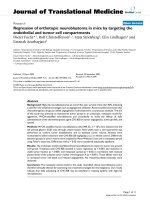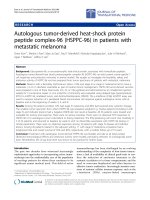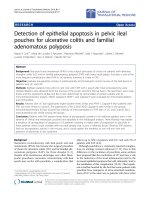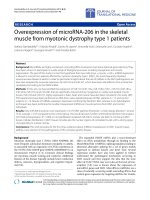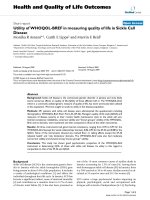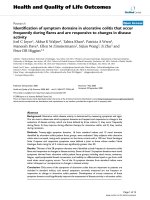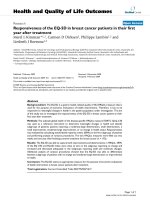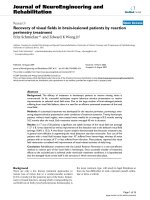báo cáo hóa học: " Responsiveness of EORTC QLQ-C30, QLQ-CR38 and FACT-C quality of life questionnaires in patients with colorectal cancer" pptx
Bạn đang xem bản rút gọn của tài liệu. Xem và tải ngay bản đầy đủ của tài liệu tại đây (267.87 KB, 10 trang )
RESEARCH Open Access
Responsiveness of EORTC QLQ-C30, QLQ-CR38
and FACT-C quality of life questionnaires in
patients with colorectal cancer
Lionel Uwer
1,2
, Christine Rotonda
2,3,4*
, Francis Guillemin
2,3,4
, Joëlle Miny
5
, Marie-Christine Kaminsky
1
,
Mariette Mercier
4,6
, Laetitia Tournier-Rangeard
7
, Isabelle Leonard
1,2
, Philippe Montcuquet
8
, Philippe Rauch
9,3
and
Thierry Conroy
1,2,4
Abstract
Background: The aim of this study was to compare the responsiveness of the European Organization for Research
and Treatment (EORTC) quality of life questionnaires (QLQ-C30, QLQ-CR38) and the Functional Assessment of
Cancer Therapy-colorectal version 4 questionnaire (FACT-C).
Method: This prospective study included 127 patients with colorectal cancer: 71 undergoing chemotherapy and 56
radiation therapy. Responsiveness statistics included the Standardized Response Mean (SRM) and the Effect Size (ES).
The patient’s overall assessment of his/her change in state of health status was the reference criterion to evaluate the
responsiveness of the QoL questionnaires.
Results: 34 patients perceived their health as stable and 17 as improved between the first and the fourth courses
of chemotherapy. 21 patients perceived their health as stable and 22 as improved between before and the last
week of radiotherapy.
The responsiveness of the 3 questionnaires differed according to treatments. The EORTC QLQ-C30 questionnaire
was more responsive in patients receiving chemotherapy, particulary functional scales (SRM > 0.55). The QLQ-CR38
and the FACT-C que stionnaires pro vided little clinically relevant information during chemotherapy or radiotherapy.
Conclusion: The EORTC QLQ-C30 questionnaire appears to be more responsive in patients receiving
chemotherapy.
Keywords: Colorectal cancer, Quality of life, EORTC QLQ-C30, EORTC QLQ-CR38, FACT-C, Responsiveness
Introduction
Colorectal cancer (CRC) is common in Western socie-
ties. The management of locally advanced rectal cancer
includes preoperative chem oradiotherapy and surgery.
Surgery followed by adjuvant or palliative chemotherapy
is th e standard of care of localized or advanced stages of
CRC. These treatments may affect the patient’ squality
of life (QoL) and may be responsible for late side-effects
or sequelae. QoL assessment is essential to better inform
clinical decisions by providing insights into the patient’s
experiences of disease and treatment [1].
Many questionnaires assess the QoL of patients with
CRC. The more frequently u sed are [2]: the European
Organization for Research and Treatment of Cancer
(EORTC) QoL QLQ-C30 [3], validated in all European
languages [4], the colorectal module QLQ-CR38 [5], and
the Functional Assessment of Cancer Therapy-General
version FACT-G [6] named FACT-C [7] when specific
concerns of patients with CRC ar e added to common
items to all cancer patients. Few data are avai lable in the
literature on the responsiveness of these questionnaires
[4,8].
Responsiveness, or “sensitivity to change”, an essential
property of measuring instrument, is defined as the abil-
ity to detect a clinically meaningful change [9-12], such
as a change that clinicians or patients think is
* Correspondence:
2
Nancy-University, Paul Verlaine Metz University, Paris Descartes University,
EA 4360 Apemac, Nancy, France
Full list of author information is available at the end of the article
Uwer et al. Health and Quality of Life Outcomes 2011, 9:70
/>© 2011 Uwer et al; lice nsee BioMed Central Ltd. This is an Open Access article distrib uted under the terms of the Creative Commons
Attribution License ( censes/by/2.0), which permits unrestricted use, distribution, and reproduction in
any medium, provided the original work is properly cited.
discernable and important. Changes may be sponta-
neous, due to progression of the disease or may be
induced by a therapeutic intervention [13,14]. In a clini-
cal trial, the knowledge of instrument’ s responsiveness
helps in the selection of measures, in sett ing the correct
sample size and assists in prioritising the number of
outcomes to be assessed. Responsiveness is the most
importantpropertyofaquestionnaireforusewithin
randomized trials as fewer patients need to be included
to demonstrate a significant difference b etween two
treatment options when a more sensitive questionnaire
is available [1] would be more accurately detected by
disease-specific scales, although they have a narrow
focus, have generally been reported to be more respon-
sive than generic health status measures [15]. The
EORTC QLQ-CR38 or FACT-C may be more relevant
for patients with CRC and their physicians, as they are
set to more accurately detect specific clinical effects of
the disease. Nevertheless, the selection of instrument for
use in a cancer trial should depend on the fit between
its content and the objectives of the study [8] and the
responsiveness of questionnaires may also vary accord-
ing to the treatments received.
Both instruments (QLQ-C30followedbyQLQ-CR38
and FACT-C) have subscales measuring physical, emo-
tional, functional, and social aspects; the EORTC QLQ-
C30 has additional subscales and single ite ms assessing
cognitive function, symptoms, and the financial impact of
the disease. The QLQ-CR38 is mainly centered on surgery
consequences and has some items about radiotherapy
side-effects [16]. The EORTC instrument focuses on the
QoL consequences of physical limitat ions and on clinical
symptoms; it may be appropriate for use in clinical trials,
while FACT-C emphasises r ather satisfaction with daily
life [8]. In addition, these questionnaires are different in
regard to the phrasing of the items: the EORTC ins tru-
ment uses questions, and the FACT-C uses statements.
This study was therefore designed to compare the
responsiveness of the EORTC QLQ-C30, QLQ-CR38
and FACT-C questionnaires, based on the course of
QoL during different treatments for CCR.
Patients and me thods
This is a prospective longitudinal study carried out in
four French hospitals (Alexis Vautrin Cancer Centre,
Nancy and Oscar Lambret Cancer Centre, Lille; Nancy
and Besançon u niversity hospitals) between April 2003
and February 2007. The institutional review board had
approved the study.
Patients
Patients who had histologically proven colorectal adeno-
carcinoma, an age above 18 years, able to read, speak
and write French, no psychological condition that might
potentially hamper compliance with QoL assessment,
and life expectancy greater than 3 months were eligible.
Patients were not eligible if participating in another
QoL survey, in case of cognitive impairment, or previous
or concomitant other cancer. Written informed consent
and permission from an ethics committee were obtained.
Two different groups of patients were recruited:
- before starting adjuvant or pal liative chemotherapy
(all fluoropyrimidine based regimens) (chemotherapy
group),
- before starti ng preoperative radiotherapy for rectal
cancer (radiotherapy group): Preoperative radiother-
apy delivered 45 grays in 25 fractions (five weeks)
with or without concomitant fluoropyrimidine.
Measures and data collection procedure
Patients’ characteristics and clinical data were collected at
baseline. QoL assessment was performed using three ques-
tionnaires: the Functional Assessment of Cancer Therapy-
Colorectal (FACT-C version 4.0), the EORTC QLQ-C30
version 3.0 and the EORTC QLQ-CR38. The EORTC col-
orectal questionnaire (QLQ-CR38) was developed to be
used in conjunction with the QLQ-C30. The FACT-C
combines the FACT-G with a CRC subscale (CCS). The 3
questionnaires FACT-C, QLQ-C30 and QLQ-CR38 were
administrated together. The order in which these ques-
tionnaires were administrated to patients was randomized
by center from a pre-established table of random number
to avoid any systematic order.
According to the type of treatment, different timings
of QoL measurements were used:
- Patients treated by adjuvant or p alliative chemother-
apy were asked to complete all questionnaires (EORTC
QLQ-C30, EORTC QLQ-CR38 and FACT-C) before the
first, the third and the fourth courses of chemotherapy
administered at 2 weeks interval.
- Patients treated by preoperative radiotherapy for rec-
tal cancer were asked to fill the three questionnaires
before the first fraction and during the last week of
radiotherapy.
The developers of the EORTC QLQ-C30 provide infor-
mation on what a clinically important difference is for this
questionnaire. They have suggested that in groups, the
mean change scores was about 5 to 10 in the means scores
for those who reported a “little” change, about 10 to 20 for
those who reported “moderate” change, and more than 20
for those who reported a large change [17].
The change in health status was assessed between
baseline and before the fourth course for patients receiv-
ing chemotherapy, and between baseline and the last
week of radiotherapy for patients treated with radiation
therapy. The patient’ s overall assessment of his/her
Uwer et al. Health and Quality of Life Outcomes 2011, 9:70
/>Page 2 of 10
change in state of health was the reference criterion to
evaluate the responsiveness of the questionnaires. The
question was worded: “Compared to the situation befo re
your treatment, how would you evaluate your state o f
health?” It was recorded according to seven levels of
answers: the first 3 answers (much wo rse, moderately
worse and slightly worse) were considered to reflect a
clinically significant deterioration, the fourth answer (no
change) was considere d to reflect stability and the last 3
answers (slightly better, moderately better and much
better) were considered to reflect a clinically significant
improvement [18].
Statistical analysis
Statistical analysis was conducted using a pre-specified
plan. Completed questionnaires were scored according
to the developers’ instructions. Transformed FACT-C
subscores were determined by converting the original
values linearly to a range of 0 (worst QoL) to 100 (best
QoL) to facilitate readability of the tables. QoL scores
(quantitative variables in each scales) were expressed as
mean and standard deviation. The Wilcoxon test was
used to test differences between values of the two mea-
surements in each group. Statistical significance for ana-
lyses was considered to be at p < 0.05.
Test-retest reliability was assessed between the third
and the fourth courses of chemotherapy at two weeks
interval in patients who reported no change in their state
of health. To assess reliability, a sample of 30 patients
with stable health between the 2 testing times was con-
sidered as sufficient because it can be approximated by
the standard normal distribution. The Intra-class correla-
tion coefficient (ICC) was computed from a one-way ana-
lysis of variance (ANOVA). ICC is the ratio of the
variance of interest to the sum of the variance of interest
plus error [19]. PROC GLM in SAS 9.0. calculated the
between and within subject variation, the ICC and its
confidence limits. A value between 0 and 0.2 is usually
considered to be poor, between 0.2 and 0.4 fair, between
0.4 and 0.6 mo derate, between 0.6 and 0.8 good, and a
value greater than 0.8 is usually considered to be excel-
lent [20].
Responsivene ss statistics included the Standardized
Response Mean (SRM) and the Effect Size (ES). It is
based on the comparison of signal (mean change in
clinically changed patients) to noise (SD of change in
stable patients). The SRM is calculated as the mean
change in scores between baseline and follow-up divided
by the standard deviation (SD) of this change [21]. The
ES is used to interpret differences or changes in health
related to quality of life following treatment. It is calcu-
lated as the mean change in scores between baseline
and follow-up divided by the SD of the baseline score
[12]. Effect size of 0.2, 0.5 and 0.8 is typically considered
as small, moderate and large changes, respectively [20].
We used the same threshold levels for SRM. Cohen’ s
effect size may be influenced by the degree of homoge-
neity or heterogeneity in the sample. SRM is sensitive to
within-subject variability, while ES is sensitive to
between-subjects variability. Indeed, the ES statistics
relates change over time to the SD of baseline scores
and the SRM compares change to the SD of change.
Responsiveness was assessed using data from patients
deemed to have improved as recommended [22]. We
used a bootstrap methods to estimate 95% confidence
intervals for the SRM and ES [23]. For this study, it was
estimated that a sample at least 30 patients, based on
normal distribution assumption should be used.
Data were analysed using Statistical Analysis System
software version 9.0 (Cary, North Carolina, USA, 2004)
for Windows.
Results
Sociodemographic and clinical data
Between April 2003 and February 2007, 127 patients
were enrolled in the study: 71 patients in the che-
motherapy group and 56 patients in the radiotherapy
group. Sociodemographic characteristics of the study
population and medical data are presented in Table 1.
Compliance with the study was excellent and all patients
filled all QoL questionnaires.
Between the first and the fourth courses of che-
motherapy, 56 (78.9%) patients answered the question
on the perceived change in health: five patients per-
ceived their health as worsened, 34 as stable and 17 as
improved.
Between the starting and the last week of radiother-
apy, 48 (85.7%) patients answered the question on the
change in their health: ten patients perceived their
health as worsened, 21 as stable and 22 as improved.
Test-retest reliability
The test-retest reliability of the questionnaires was stu-
died among 34 patients receiving chemotherapy who per-
ceived their health as stable (Table 2). The ICC of the
QLQ-C30 scales ranged from 0.33 for diarrhoea (ICC =
0.33; CI
95%
= [-0.003 to -0.60]) or Global QoL/GHS
ICC = 0.33; CI
95%
= [-0.01 to 0.59]) to 0.87 (CI
95%
= [0.76
to 0.93]) for physical function. The reproducibility of
nausea/vomiting subscale was fair (ICC = 0.43; CI
95%
=
[0.11 to 0.67]). The ICC of QLQ-CR38 que stionnaire was
good or excellent except for weight loss (ICC = 0.36;
CI
95%
= [0.02 to 0.63]). The reproducibility of all of the
FACT-C domains was good with ICC greater than 0.60
except for Social/Family Well-Being (ICC = 0.51; CI
95%
=
[0.23 to 0.73]).
Uwer et al. Health and Quality of Life Outcomes 2011, 9:70
/>Page 3 of 10
Description of the QoL scores and responsiveness of the
questionnaires
- Chemotherapy group
Because only 5 patients perceived their health as wor-
sened, the responsiveness has been studied only in patients
with improvement of their health. Between the first and
the fourth courses of chemotherapy, 17 patients perceived
their health as improved: 12 patients were slightly better, 3
moderately better and only 2 patients were much better.
All patients except two had previous surgery for resection
of the primary tumor before chemotherapy. Seven patients
received adjuvant chemotherapy and 10 patients were
treated for metastatic disease. In these patients with
improved health status, no difference in changes of scores
between baseline and before the fourth course of che-
motherapy has been found between patients with adjuvant
treatment versus those treated for metastatic disease (data
not shown).
Description of scores (Table 3)
Between the first a nd the fourth courses of chemother-
apy, patients reported a “ moderate” change for 5 func-
tional scales (difference of scores greater than 10 points)
andtheyreportedalargechangefortherolefunction
scale (difference of scores greater than 20 points). All
these scales had a statistically significant (p < 0.05)
except for the “social function” scale.
Patients also reported a “moderate” change of fatigue,
pain, insomnia and a ppetite loss with a decrease of
these symptoms (difference of scores greater than 10
points). But only the “fatigue” domain had a statistically
significant (Δ = -16.3 (SD = 25.8), p = 0.02).
Considering the QLQ-CR38 scores, a statistically sig-
nificant difference of the scores was only observed for
the future perspective single item and the weight lo ss
scale which showed “very much” change with a differ-
ence scores greater than 20 points (Δ
future perspective
=
+22.9 (S D = 31.5) , p = 0.01 and Δ
weight loss
=-22.9
(SD = 33.8), p = 0.02).
For the FACT-C scales, the only statistically significant
difference of the scores was observed for the Functional
Well-Being subscale (Δ = +10.0 (SD = 13.2), p = 0.007).
Responsiveness (Table 3) The indicators of responsive-
ness (SRM and ES) have been calculated f or patients
with improved health. The physical, role, emotional and
cognitive function and the fatigue scale of the QLQ-C30
appeared to be responsive with values of the indicators
(SRM and ES) greater than 0.5 reflecting moderate abil-
ity to detect an effect of chemotherapy treatment. The
SRM for the global QoL/GHS score reflected moderate
ability to detect treatment effect (SRM = 0.96). The
indicators of responsiveness for the future perspective,
weight loss and sexual dysfunction in women subscales
of the QLQ-CR38 questionnaire reflected moderate abil-
ity to detect an effect of chemotherapy on change of
clinical state (absolute values of SRM and ES between
0.51 and 0.79).
The changes in clinical state evaluated by the total
score of the FACT-C questionnaire were not significant
(SRMandES<0.20).Onlyamoderateabilityofthe
Functional Well-Being scale to detect an effect of treat-
ment was observed (SRM a nd ES between 0.58 and
0.75).
Table 1 Sociodemographic and clinical patient characteristics
Chemotherapy Group Radiotherapy Group p Total
N 71 56 127
Age (years) 60 66 0.001 64
Median
Gender (%)
Men 38 (53) 43 (77) 0.007 81 (64)
Women 33 (47) 13 (23) 46 (36)
Marital status (%)
Single 3 (4) 4 (7) 7 (6)
Married 53 (69) 44 (80) 0.52 97 (76)
Widower 7 (6) 5 (4) 12 (9)
Divorced 8 (21) 3 (9) 11 (6)
Localisation (%)
Colon 55 (76) 1 (2) < .0001 56 (44)
Rectum 16 (24) 55 (98) 71 (56)
Disease status (%)
Non metastatic 30 (42) 50 (89) 80 (63)
Metastatic 40 (56) 5 (9) < .0001 45 (35)
Unknown 1 (2) 1 (2) 2 (2)
Uwer et al. Health and Quality of Life Outcomes 2011, 9:70
/>Page 4 of 10
- Radiotherapy group
Bet ween before radiotherapy and the last week of treat-
ment, ten patients perceived their health as worsened,
21 as stable and 22 as improved. Among 22 patients
with improvement, 16 patients were slightly better, 4
moderately better and only 2 patients were much better.
Description of scores (Table 4)
A “small” deterioration of physical (Δ = -6.5, SD = 16.4),
role (Δ = -6.3, SD = 28.1), and socia l functioning (Δ =
-5.3, SD = 22.0) of QLQ-C30 and a “moderate” increase
of constipation (Δ = +12.1, SD = 24.2) was observed
during the last week of radiotherapy as compared to
baseline; these dif ferences were statistically significant
only for constipation (p = 0.03)
No statistically significant changes were observed in
QLQ-CR38 scales e xcept for radiation-induced effects
micturition scale (Δ = +19.3 (SD = 21.9), p = 0.0006)
and sexual enjoyment scale (Δ = - 26.7 (SD = 30.6), p =
0.02). Indeed, patients reported a large decrease in sex-
ual enjoyment scores. For the FACT-C scales, no statis-
tically significant differences of the scores including the
global score were observed.
Responsiveness (Table 4) The indicators of responsive-
ness (SRM and ES) have been calculated f or patients
who perceived their health as improved. The SRM for
the global QoL/GHS score was 0.21, reflecting a mini-
mal ability to detect an effect of radiotherapy treatment
on clinical change, as well as the pain (SRM = 0.30) and
constipation (SRM = 0.50) subscales or items.
Indicators of responsiveness for the various scores of
the QLQ-CR38 questionnaire reflected a fair ability to
detect a treatment effect on clinical change. Only indica-
tors for radiation-induced effects on micturition and
sex ual enjoyment (absolute values greater tha n or equal
to 0.71) reflected a good responsiveness.
Analysis of responsiveness in all domains and the glo-
bal score of the FACT-C questionnaire proved a fair
ability to detect a particularly treatment effect. (absolute
values of SRM and ES indices between 0.14 and 0.45).
Discussion
Test-retest reliability and responsiveness are two essen-
tial properties of a measuring instrument. To be respon-
sive, a questionnaire should be reproducible [24,25]: if
an instrument is unreliable, it will be less responsive.
In CRC patients, the reproducibility of the EORTC
QLQ-C30 questionnaires is good or excellent except for
nausea/vomiting subscale (which can be explained by
changes in the symptom in tensity and changes in antie-
metic treatment) and surprisingly for QoL/GHS question-
naire. The reproducibility of QLQ-CR38 questionnaire
was good or excellent. The FACT-C showed a good repro-
ducibility except for the Social/Family Well-Being subscale
(ICC < 0.60). The responsiveness of each of these 3 ques-
tionnaires, according to the patient’s assessment of his/her
change in their state of health, differs according to treat-
ment types: the EORTC QLQ-C30 questionnaire, com-
pared to the QLQ-CR38 and FACT-C, appears as the
Table 2 Test-retest reliability (ICC) of the QLQ-C30, QLQ-
CR38 and FACT-C for patients with stable colorectal
cancer undergoing chemotherapy (data obtained
between the third and the fourth treatment)
n ICC
a
95% CI
b
EORTC QLQ-C30:
Functional scales:
Physical function 34 0.87 0.76-0.93
Role function 33 0.80 0.64-0.90
Emotional function 34 0.73 0.52-0.85
Cognitive function 34 0.79 0.62-0.89
Social function 34 0.84 0.71-0.92
Global QoL/GHS 34 0.33 -0.01-0.59
Symptom scales:
Fatigue 34 0.82 0.67-0.90
Pain 34 0.74 0.54-0.86
Nausea and vomiting 34 0.43 0.11-0.67
Single items
c
:
Dyspnoea 34 0.63 0.37-0.79
Sleep disturbance 34 0.76 0.58-0.87
Appetite loss 34 0.74 0.54-0.86
Diarrhoea 34 0.33 -0.003-0.60
Constipation 34 0.54 0.25-0.74
Financial impact 34 0.75 0.56-0.87
EORTC QLQ-CR38:
Functional scales:
Body image 32 0.71 0.49-0.85
Future perspective 32 0.76 0.56-0.87
Sexual functioning 31 0.82 0.66-0.91
Sexual enjoyment 11 NA NA
Symptom scales:
Radiation-induced effects micturition 32 0.67 0.43-0.82
Chemotherapy side effects 32 0.70 0.47-0.84
General gastrointestinal symptoms 32 0.65 0.39-0.81
Defecation problems 26 NA NA
Stoma-related problems 6 NA NA
Sexual dysfunction of men 14 NA NA
Sexual dysfunction of women 3 NA NA
Weight loss 32 0.36 0.02-0.63
FACT-C:
Physical Well-Being 34 0.76 0.57-0.87
Social/Family Well-Being 33 0.51 0.23-0.73
Emotional Well-Being 34 0.79 0.62-0.89
Functional Well-Being 34 0.73 0.52-0.85
Colorectal Cancer Specific 34 0.77 0.59-0.90
FACT-C total score 34 0.75 0.55-0.87
Trial Outcome Index-Colorectal 34 0.82 0.66-0.90
a
Intraclass correlation coefficient;
b
confidence interval; NA: Not Applicable
(n < 30)
Uwer et al. Health and Quality of Life Outcomes 2011, 9:70
/>Page 5 of 10
most appropriate instrument to measure and to detect an
effect of chemotherapy on QoL changes. Indicators of
responsiveness of the global QoL/GHS score reflect mod-
erate ability (ES) or a good ability (SRM) to detect an
effect of chemotherapy on change of health status. In our
study, the QLQ-CR38 and the FACT-C questionnaires
provided little clinically relevant information duri ng che-
motherapy or radiotherapy. Four of the 12 scores of the
Table 3 Mean scores before the first course of chemotherapy, changes of scores between the first and the fourth
courses of responsiveness statistics in patients who perceived improved health (n = 17)
n Score before 1
st
chemother.Mean (SD
a
) Difference
Mean
(SD
a
)
P
b
SRM
c
(CI 95%) ES
d
(CI 95%)
EORTC QLQ-C30:
Functional scales
e
:
Physical function 16 67.8 (30.2) +14.9 (22.5) 0.02 0.64 (0.19;1.08) 0.48 (0.14;0.86)
Role function 16 55.9 (39.1) +21.9 (16.7) 0.03 0.60 (0.08;1.13) 0.56 (0.10;1.07)
Emotional function 17 69.6 (16.1) +16.2 (16.7) 0.003 0.84 (0.28;1.54) 1.00 (0.35;1.68)
Cognitive function 17 77.5 (20.4) +10.8 (16.6) 0.02 0.64 (0.16;1.29) 0.52 (0.14;1.09)
Social function 17 62.7 (34.1) +13.7 (38.3) 0.16 0.35 (-0.17;0.88) 0.40 (-0.20;0.89)
Global QoL/GHS 17 54.9 (20) +14.2 (14.7) 0.001 0.96 (0.38;1.67) 0.71 (-0.23;1.44)
Symptom scales
f
:
Fatigue 16 42.8 (27.9) -16.3 (25.8) 0.02 - 0.63 (-1.07;-0.19) - 0.58 (-1.13;-0.15)
Pain 17 28.4 (31) -17.6 (37.5) 0.07 - 0.47 (-0.90;-0.09) - 0.56 (-1.07;-0.05)
Nausea and vomiting 16 12.7 (22.5) -6.2 (21.8) 0.27 - 0.28 (-0.69;0.28) - 0.27 (-0.66;0.25)
Single items
f
:
Dyspnoea 16 21.6 (26.2) -8.3 (25.8) 0.22 - 0.32 (-1.05;0.65) - 0.31 (-0.89;0.17)
Sleep disturbance 16 45.1 (31) -12.5 (38.2) 0.21 - 0.32 (-0.86;0.19) - 0.40 (-0.98;0.38)
Appetite loss 16 29.4 (30.9) -12.5 (26.9) 0.08 - 0.46 (-0.93;0.01) - 0.40 (-0.87;0.08)
Diarrhoea 17 19.6 (23.7) +3.9 (33.1) 0.63 0.11 (-0.38;0.64) 0.16 (-0.41;1.17)
Constipation 17 17.6 (29.1) -5.9 (27.0) 0.38 - 0.21 (-0.75;0.31) - 0.20 (-0.67;0.31)
Financial impact 17 5.9 (17.6) +3.9 (11.1) 0.16 0.35 (0.11;0.57) 0.22 (-0.05;0.49)
EORTC QLQ-CR38:
Functional scales
e
:
Body image 16 81.7 (28) +3.8 (14.2) 0.30 0.27 (-0.33;0.69) 0.13 (-0.13;0.37)
Future perspective 16 45.1 (28.7) +22.9 (31.5) 0.01 0.70 (0.27;1.27) 0.79 (0.27;1.38)
Sexual functioning 14 20.2 (20.9) +5.9 (16.8) 0.21 0.37 (-0.28;0.86) 0.28 (-0.15;0.83)
Sexual enjoyment 7 54.2 (43.4) +9.5 (41.8) 0.57 0.23 (-0.56;1.28) 0.21 (-0.73;0.91)
Symptom scales
f
:
Radiation-induced effects micturition 16 23.5 (15.2) +4.8 (15.7) 0.23 0.30 (-0.23;0.91) 0.32 (-0.23;0.89)
Chemotherapy side effects 16 18.6 (19.5) +4.2 (18.4) 0.38 0.23 (-0.30;1.1) 0.21 (-0.77;0.92)
General Gastrointestinal symptoms 16 23.0 (12) -7.0 (14.3) 0.07 -0.49 (-1.38;0.11) - 0.58 (-1.45;0.17)
Defecation problems 13 15.4 (11.5) -1.8 (8.2) 0.43 -0.22 (-1.10;0.41) - 0.16 (-0.65;0.32)
Stoma-related problems 4 31.0 (21.5) -1.2 (13.7) 0.87 -0.10 (-1.15;1.02) - 0.05 (-1.96;2.43)
Sexual dysfunction of men 8 43.8 (41.7) -2.1 (35.0) 0.87 -0.06 (-1.43;0.82) - 0.04 (0.84;0.64)
Sexual dysfunction of women 2 8.3 (11.8) -8.3 (11.8) 0.50 -0.70 (-1.44;-0.31) -0.70 (-1.44;-0.31)
Weight loss 16 25.5 (34.4) -22.9 (33.8) 0.02 -0.67 (-1.01;-0.35) - 0.66 (-1.01;-0.36)
FACT-C
e
:
Physical Well-Being 17 78.0 (15.3) +5.3 (15.8) 0.18 0.34 (-0.20;0.85) 0.34 (-0.17;0.87)
Social/Family Well-Being 17 74.3 (21.1) +3.2 (18.3) 0.48 0.17 (0.47;0.59) 0.15 (-0.39;0.48)
Emotional Well-Being 17 74.3 (19.6) +3.3 (13.7) 0.34 0.24 (-0.32;0.64) 0.16 (-0.16;0.48)
Functional Well-Being 17 50.8 (17.1) +10.0 (13.2) 0.007 0.75 (0.20;1.27) 0.58 (0.19;0.93)
Colorectal Cancer Specific 16 69.6 (10.6) +3.9 (12.9) 0.25 0.30 (-0.26;0.88) 0.36 (-0.27;0.98)
FACT-C total score 17 69.5 (8.6) +1.6 (9.0) 0.49 0.19 (-0.36;0.71) 0.18 (-0.35;0.81)
Trial Outcome Index-Colorectal 17 66.4 (10.6) +4.7 (13.0) 0.152 0.36 (-0.20;0.96) 0.44 (-0.29;0.99)
a
Standard Deviation.
b
Wilcoxon test for the difference.
c
Standardized Response Mean.
d
Effect Size.
e
Higher score indicates a higher level of functioning or better quality of life.
f
Higher score indicates more symptoms/problems. Bold indicate p values < 0.05.
Uwer et al. Health and Quality of Life Outcomes 2011, 9:70
/>Page 6 of 10
Table 4 Mean scores before the radiotherapy, change of scores between before and the last week of radiotherapy and
responsiveness statistics in patients who perceived improved health (n = 22)
n Score before radiotherapy Mean (SD
a
) Difference Mean (SD
a
)P
b
SRM
c
(CI 95%) ES
d
(CI 95%)
EORTC QLQ-C30:
Functional scales
e
:
Physical function 22 83.9 (18.4) -6.5 (16.4) 0.08 - 0.39 (-0.78;0.02) - 0.35 (-0.85;0.21)
Role function 21 74.6 (27.2) -6.3 (28.1) 0.07 - 0.22 (-0.74;0.22) -0.23 (-0.78;0.21)
Emotional function 22 79.2 (17.8) +3.8 (14.2) 0.23 0.26 (-0.19;0.67) 0.21 (-0.15;0.57)
Cognitive function 22 94.7 (7.9) -4.5 (15.6) 0.19 - 0.29 (-0.67;0.17) - 0.57 (-0.55;0.21)
Social function 22 78.8 (24.2) -5.3 (22.0) 0.27 - 0.24 (-0.69;0.21) - 0.21 (-0.78;0.16)
Global QoL/GHS 22 54.9 (22.7) +5.7 (26.4) 0.32 0.21 (-0.32;0.53) 0.25 (-0.24;0.75)
Symptom scales
f
:
Fatigue 22 38.9 (25.1) +2.0 (28.4) 0.74 0.07 (-0.37;0.56) 0.08 (-0.37;0.70)
Pain 22 23.5 (23.9) +8.3 (27.6) 0.17 0.30 (-0.16;0.84) 0.34 (-0.16;1.04)
Nausea and vomiting 22 2.3 (7.8) +3.0 (12.2) 0.26 0.24 (-0.21;0.70) 0.38 (-0.75;1.33)
Single items
f
:
Dyspnoea 21 11.1 (16.1) 0.0 (14.9) 1.00 0.0 (-0.52;0.44) 0.0 (-0.41;0.38)
Sleep disturbance 22 28.8 (34.6) -7.6 (35.5) 0.33 - 0.21 (-0.62;0.30) - 0.21 (-0.64;0.30)
Appetite loss 21 20.6 (28.8) +4.8 (35.4) 0.54 0.13 (-0.31;0.66) 0.16 (-0.32;0.91)
Diarrhoea 22 28.8 (31.4) -1.5 (33.3) 0.83 - 0.04 (-0.56;0.39) - 0.04 (-0.48;0.56)
Constipation 22 15.2 (24.6) +12.1 (24.2) 0.03 0.50 (0.06;0.97) 0.49 (0.06;1.20)
Financial impact 21 10.6 (26.0) +5.7 (26.4) 0.33 0.22 (0.17;0.31) 0.06 (-0.15;0.24)
EORTC QLQ-CR38:
Functional scales
e
:
Body image 20 90.9 (16.3) -3.3 (14.5) 0.32 - 0.23 (-0.7;0.27) - 0.20 (-0.81;0.50)
Future perspective 21 56.1 (26.0) +4.8 (21.8) 0.33 0.21 (-0.23;0.72) 0.18 (-0.21;0.57)
Sexual functioning 20 16.7 (27.9) -5.8 (21.8) 0.24 - 0.26 (-0.76;0.19) - 0.20 (-0.54;0.17)
Sexual enjoyment 10 33.3 (49.4) -26.7 (30.6) 0.02 - 0.87 (-1.79;-0.45) - 0.53 (-1.03;-0.15)
Symptom scales
f
:
Radiation-induced effects
micturition
21 21.7 (22.6) +19.3 (21.9) 0.0006 0.88 (0.42;1.44) 0.85 (0.36;1.50)
Chemotherapy side
effects
21 15.2 (23.6) +5.3 (13.0) 0.08 0.40 (-0.11;0.89) 0.22 (-0.15;0.55)
General Gastrointestinal
symptoms
21 26.7 (14.9) -0.4 (11.9) 0.88 - 0.03 (-0.50;0.46) 0.02 (-0.38;0.36)
Defecation problems 19 37.6 (21.6) -1.5 (14.8) 0.66 - 0.10 (-0.59;0.41) - 0.07 (-0.42;0.27)
Stoma-related problems 1 9.5 (00.0) +23.8 (-) - - -
Sexual dysfunction of
men
9 35.9 (44.5) +7.4 (20.6) 0.31 0.35 (-0.28;1.09) 0.16 (-0.09;0.65)
Sexual dysfunction of
women
2 16.7 (23.6) +16.7 (0.0) 1.00 0 0.70 (0.65;1.10)
Weight loss 21 28.8 (34.6) +1.6 (38.7) 0.85 0.04 (-0.40;0.55) 0.04 (-0.43;0.67)
FACT-C
e
:
Physical Well-Being 19 81.4 (16.4) -5.0 (14.3) 0.15 - 0.34 (-0.77;0.17) - 0.30 (-0.94;0.10)
Social/Family Well-Being 19 71.3 (25.7) -7.4 (16.2) 0.06 - 0.45 (-0.96;0.09) - 0.28 (-0.63;0.03)
Emotional Well-Being 19 77.5 (17.6) 0 (12.7) 1.00 0.0 (-0.78;0.31) 0.0 (-0.34;0.37)
Functional Well-Being 18 50.1 (20.0) -2.5 (17.1) 0.55 - 0.14 (-0.71;0.40) - 0.12 (-0.56;0.35)
Colorectal Cancer
Specific
19 67.7 (11.5) -3.2 (12.3) 0.27 - 0.26 (-0.64;0.24) - 0.28 (-0.80;0.18)
FACT-C total score 19 69.1 (11.4) -3.0 (8.5) 0.14 - 0.35 (-0.96;0.19) - 0.26 (-0.64;0.15)
Trial Outcome Index-
Colorectal
19 65.7 (13.7) -2.6 (10.2) 0.29 - 0.25 (-0.78;0.31) - 0.18 (-0.60;0.20)
a
Standard Deviation.
b
Wilcoxon test of the change.
c
Standardized Response Mean.
d
Effect Size.
e
Higher score indicates a higher level of functioning or better quality of life.
f
Higher score indicates more symptoms/problems. Bold indicate p values < 0.05.
Uwer et al. Health and Quality of Life Outcomes 2011, 9:70
/>Page 7 of 10
QLQ- CR38 are related to sexuality and many answ ers to
questions on this top ic were missing. These conclusions
are similar whatever the indicator of responsiveness used:
Standardized Response Mean and Effect Size, all results
going in the same direction.
Sensitivity of these questionnaires to detect change
compared to the patient’s assessment significantly differs
according to the type of treatment (chemotherapy or
radiotherapy). The best correlation between QoL assess-
ment by self-rating questionnaires and the patient’ s
overall assessment of his/her change in state of health is
observed in patients receiving chemotherapy but only
with the QLQ-C30. Indeed, m easurements of functional
scales and global QoL scores of the QLQ-C30 question-
naire are the most sensitive except for social f unction
scale.
Our results suggest a lack of sensitivity of these QoL
questionnaires compared to the patient’s overall assess-
ment of his/her change in state of health. These results
of responsiveness in patients receiving chemotherapy are
confirmed by the evolution of the QoL scores between
the first and the fourth course of chemotherapy. Indeed,
a clinical relevant variation w as observed for all func-
tional scales by the QLQ-C30, with mean difference
superior to 10 points in ten scales and superior to 5
points for all scales.
These results can be explained by items on che-
motherapy side-effects such as fatigue. No s ignificant
score’s variations appeared with the FACT-C question-
naire which could be because this scale summates indi-
vidual items that may not be changing in the same
direction. Only the Functional Well-Being subscale
reflects a good ability to detect an effect of chemother-
apy on change of health status in patients.
That is likely to explain that this questionnaire is less
responsive than the EORTC QLQ-C30.
It should be noted that, as SRM is unrelated to sample
size and unit of measure, it lends itself to comparison
between different measures which have been tested on
samples of different sizes.
Interpretation of the results of the course of QoL
scores and their responsiveness for patients receiving
chemotherapy was performed independently of the che-
motherapy regimen and of the disease status.
The EORTC QLQ-C30 detect QoL impairments in
dimensions that are not specifically related to the primary
cancer [26] and to t he specific t reatment. Consequently,
for patients t reated by radiotherapy with specific conse-
quences, the indicators of responsiveness of the EORTC
QLQ-C30 are in terpreted a s poor for the most par t of
functional or symptom scales and s ingle items. The spe-
cific consequences of rectal radiotherapy are more accu-
rately detected by adapted disease-speci fic subscales. The
CCR Specific, the TOI Colorectal subscales and the
FACT-C total score have been shown to be more respon-
sive than the four general domains in this study such as
previously shown by Ward et al [7]. Yost et al [27] identi-
fied the minimal important difference (MID): 1-2 points
for the CCR specific, 4-6 points for the TOI colorectal
and 5-8 points for the FACT-C, original 0-28, 0-84 and
0-136 scale respectively.
However, we did not observe these results for these 3
subscales in patients ongoing radiotherapy.
The FACT-G questionnaire seems particularly useful as
it provides a global score making it easier to use in the
context of therapeutic trials [15]. It includes only four
questions on symptoms and it emphasises rathe r satisfac-
tion with daily life. It may investigate psychological, social
and familial well-being more thoroughly than the
EORTC QLQ-C30. The colorectal module (FACT-C) is
simple and comprises only nine questions. However, in
this study, assessment of QoL by FACT-C questionnaire
and its responsiveness a re not conclusive. This res ult
suggests the non-relevance of CCR Specific subscale of
the FACT-C.
These 3 questionnaires referred to QoL issues are
structured differently. Indeed, t he QLQ-CR38 contains
more symptoms items. The FACT-C questionnaire
investigates more functional domains like QLQ-C30.
The two specific questionnaires (QLQ-CR38 and FACT-
C) have been developed for measuring the same diseas e
so they might be comparable. Nevertheless, o nly few
items are similar (for example: questions about body
image and stoma).
Recently an updated version of the QLQ-CR38, the
QLQ-CR29, has been developed [28,29]. It has revised
scales about sexual functioning and gastrointestinal
function to improve participation and compliance.
Indeed, the sexual domain is limited to 2 items and this
questionnaire separates items for patients with and with-
out stoma.
A limitation of this study is that the responsiveness
analysis relied only on patients who perceived their
health as improved. We did not analyse the responsive-
ness in patients with a decline i n health due to the low
number of patients. The response-shift phenomenon can
be a possible explanation for the large percentage of
patients who reported an improvement in their health
status, while onl y a small percentage of participants
reported a decline in health status. Response-shift can be
considered the result of an adaptive response to a chan-
ged health status, and as such is viewed as a positive phe-
nomenon. Several studies showed that it is plausible that
a change in health perception is not primarily introduced
by an intervention (e.g. chemotherapy), but by coping
with the disease itself [30,31].
Another limitation is that the questionnaire scales are
differently constructed, therefore, it was difficult to
Uwer et al. Health and Quality of Life Outcomes 2011, 9:70
/>Page 8 of 10
compare directly the responsiveness of these question-
naires. Indeed, while some QoL measures include single
symptoms items, others include summated scales. For
example “ diar rhea” ismeasuredbyasingleitemin
QLQ-C30 questionnaire. However, diarrhea is part of
the “colorectal cancer specific” concerns in FACT-C.
Nausea and pain are separate two-item symptom scales
in QLQ-C30, while they are both included in the “physi-
cal well- being” scale of FACT-C.
We studied the responsive ness during treatment but
long-term complications have not been e xamined. It
could be considered a limitation of this study. A strength
of the present study is, however, that it was performed in
various clinical situations for CRC patients.
Conclusion
Implications for practice: The present results showed that
the responsiveness of QoL questionnaires, an essential
property, is different according to the type of treatment.
We hypothesized that disease-specific scales tend to be
more responsive than generic health status measures.
Unfortunately, our results were not conclusive. We
observed that EORTC QLQ-C30 functional subscales may
be responsive to improvement in overall health state in
patients undergoing chemotherapy and we confirm that
QLQ-CR38 needs improvement. An updated version of
theQLQ-CR38,theQLQ-CR29isnowavailable[28,29].
Generic instruments provide a broader context in which
to interpret the information about change in QoL.
This study on responsiveness of the questionnaires
provides arguments for the choice of generic to assess
QoL in patients with CRC.
Implications for future research: Further investigation
of the responsiveness to change of the EORTC CR29
module is warranted.
Abbreviations
CRC: ColoRectal Cancer; EORTC: European Organization for Research and
Treatment of Cancer; ES: Effect Size; FACT-C: Functional Assessment of
Cancer Therapy-Colorectal; FACT-G: Functional Assessment of Cancer
Therapy-General; GHS: Global Health Status; QLQ-CR38: Quality-of-Life
ColoRectal module; QoL: Quality of Life; RE: Relative Efficiency; SRM:
Standardized Response Mean; TOI-C: Trial Outcome Index of FACT-C.
Acknowledgements
We gratefully acknowledge C. Carnin, P. Bataillard, E. Petit and E Lesieu for
assistance with patient interviews, Thomas Roederer at the center of clinical
epidemiology, INSERM CIE 6 University hospital Nancy for statistical
assistance. We thank the physicians G. Créhange, P. Maingon, G. Truc, J.
Fraisse, J. Cuisenier, B. Chauffert, E. Désandes and J.M. Tortuyaux who helped
to recruit patients. We also thank Sonya Eremenco, Evanston, Illinois, for
permission to use the FACT-C, and the EORTC QoL Unit, Brussels, for
permission to use the EORTC QLQ-C30 and QLQ-CR38 questionnaires. This
study was supported by grants from the French Ministry of Health Clinical
Research Hospital Program (PHRC 2004) and the cancéropole Grand-Est.
Author details
1
Centre Alexis Vautrin, Department of Medical Oncology, Nancy, France.
2
Nancy-University, Paul Verlaine Metz University, Paris Descartes University,
EA 4360 Apemac, Nancy, France.
3
INSERM, CIC-EC CIE6, Nancy, France.
4
Quality of Life in oncology platform, Canceropole Grand-Est, Nancy, France.
5
University hospital Jean Minjoz, Department of Radiation Oncology,
Besançon, France.
6
Medical and Pharmaceutical University, Department of
Biostatistics, Besançon, France.
7
Centre Alexis Vautrin, Department of
Radiation Oncology, Nancy, France.
8
Clinique Saint-Vincent, Medical
Oncology, Besançon, France.
9
Centre Alexis Vautrin, Department of Surgery,
Nancy, France.
Authors’ contributions
Conception and design: FG, TC, MM
Provision of study materials or patients: LU, JM, MCK, MM, LT, IL, PM, PR, TC
Collection and assembly of data: LU, CR, IL
Data analysis and interpretation: LU, CR, FG, TC
Manuscript writing: LU, CR, TC, FG
Final approval of manuscript: All authors contributed to the manuscript and
have read and approved its final version.
Competing interests
The authors declare that they have no competing interests.
Received: 11 April 2011 Accepted: 22 August 2011
Published: 22 August 2011
References
1. Guyatt GH, Ferrans CE, Halyard MY, Revicki DA, Symonds TL, Varricchio CG,
Kotzeva A, Valderas JM, Alonso J: Exploration of the value of health-
related quality-of-life information from clinical research and into clinical
practice. Mayo Clin Proc 2007, 82:1229-1239.
2. Garratt A, Schmidt L, Mackintosh A, Fitzpatrick R: Quality of life
measurement: bibliographic study of patient assessed health outcome
measures. BMJ 2002, 324 :1417.
3. Aaronson NK, Ahmedzai S, Bergman B, Bullinger M, Cull A, Duez NJ,
Filiberti A, Flechtner H, Fleishman SB, de Haes JC: The European
Organization for Research and Treatment of Cancer QLQ-C30: a quality-
of-life instrument for use in international clinical trials in oncology. J Natl
Cancer Inst 1993, 85:365-376.
4. Osoba D, Zee B, Pater J, Warr D, Kaizer L, Latreille J: Psychometric
properties and responsiveness of the EORTC quality of Life
Questionnaire (QLQ-C30) in patients with breast, ovarian and lung
cancer. Qual Life Res 1994, 3:353-364.
5. Sprangers MA, te Velde A, Aaronson NK: The construction and testing of
the EORTC colorectal cancer-specific quality of life questionnaire module
(QLQ-CR38). European Organization for Research and Treatment of
Cancer Study Group on Quality of Life. Eur J Cancer 1999, 35:238-247.
6. Cella DF, Tulsky DS, Gray G, Sarafian B, Linn E, Bonomi A, Silberman M,
Yellen SB, Winicour P, Brannon J: The Functional Assessment of Cancer
Therapy scale: development and validation of the general measure. J
Clin Oncol 1993, 11:570-579.
7. Ward WL, Hahn EA, Mo F, Hernandez L, Tulsky DS, Cella D: Reliability and
validity of the Functional Assessment of Cancer Therapy-Colorectal
(FACT-C) quality of life instrument. Qual Life Res 1999, 8:181-195.
8. Conroy T, Mercier M, Bonneterre J, Luporsi E, Lefebvre JL, Lapeyre M,
Puyraveau M, Schraub S: French version of FACT-G: validation and
comparison with other cancer-specific instruments. Eur J Cancer 2004,
40:2243-2252.
9. Guyatt GH, Feeny DH, Patrick DL: Measuring health-related quality of life.
Ann Intern Med 1993, 118:130-136.
10. Hawley DJ, Wolfe F: Sensitivity to change of the health assessment
questionnaire (HAQ) and other clinical and health status measures in
rheumatoid arthritis: results of short-term clinical trials and
observational studies versus long-term observational studies. Arthritis
Care Res 1992, 5 :130-136.
11. Katz JN, Larson MG, Phillips CB, Fossel AH, Liang MH: Comparative
measurement sensitivity of short and longer health status instruments.
Med Care 1992, 30:917-925.
12. Kazis LE, Anderson JJ, Meenan RF: Effect sizes for interpreting changes in
health status. Med Care 1989, 27:S178-189.
13. Guyatt G, Walter S, Norman G: Measuring change over time: assessing
the usefulness of evaluative instrum ents. JChronicDis1987,
40:171-178.
Uwer et al. Health and Quality of Life Outcomes 2011, 9:70
/>Page 9 of 10
14. Guyatt GH, Deyo RA, Charlson M, Levine MN, Mitchell A: Responsiveness
and validity in health status measurement: a clarification. Expert Rev
Anticancer Ther 2003, 3:493-504.
15. Conroy T, Blazeby JM: Health-related quality of life in colorectal cancer
patients. Expert Rev Anticancer Ther 2003, 3:493-504.
16. Guren MG, Dueland S, Skovlund E, Fossa SD, Poulsen JP, Tveit KM: Quality
of life during radiotherapy for rectal cancer. Eur J Cancer 2003,
39:587-594.
17. Osoba D, Rodrigues G, Myles J, Zee B, Pater J: Interpreting the significance
of changes in health-related quality-of-life scores. J Clin Oncol 1998,
16:139-144.
18. Jaeschke R, Singer J, Guyatt GH: Measurement of health status.
Ascertaining the minimal clinically important difference. Control Clin Trials
1989, 10:407-415.
19. Fleiss JL, Shrout PE: The effects of measurement errors on some
multivariate procedures. Am J Public Health 1977, 67:1188-1191.
20. Cohen J: Statistical Power Analysis for the Behavioural Sciences.
Academic New York; 1977.
21. Katz JN, Phillips CB, Fossel AH, Liang MH: Stability and responsiveness of
utility measures. Med Care 1994, 32:183-188.
22. Beaton DE, Bombardier C, Katz JN, Wright JG: A taxonomy for
responsiveness. J Clin Epidemiol 2001, 54:1204-1217.
23. Wasserman S, Bockenholt U: Bootstrapping: applications to
psychophysiology. Psychophysiology 1989, 26:208-221.
24. Deyo RA, Diehr P, Patrick DL: Reproducibility and responsiveness of
health status measures. Statistics and strategies for evaluation. Control
Clin Trials 1991, 12 :142S-158S.
25. Terwee CB, Dekker FW, Wiersinga WM, Prummel MF, Bossuyt PM: On
assessing responsiveness of health-related quality of life instruments:
guidelines for instrument evaluation. Qual Life Res 2003, 12:349-362.
26. Bombardier C, Melfi CA, Paul J, Green R, Hawker G, Wright J, Coyte P:
Comparison of a generic and a disease-specific measure of pain and
physical function after knee replacement surgery. Med Care 1995, 33:
AS131-AS144.
27. Yost KJ, Cella D, Chawla A, Holmgren E, Eton DT, Ayanian JZ, West DW:
Minimally important differences were estimated for the Functional
Assessment of Cancer Therapy-Colorectal (FACT-C) instrument using a
combination of distribution- and anchor-based approaches. J Clin
Epidemiol 2005, 58:1241-1251.
28. Gujral S, Conroy T, Fleissner C, Sezer O, King PM, Avery KN, Sylvester P,
Koller M, Sprangers MA, Blazeby JM: Assessing quality of life in patients
with colorectal cancer: an update of the EORTC quality of life
questionnaire. Eur J Cancer 2007, 43:1564-1573.
29. Whistance RN, Conroy T, Chie W, Costantini A, Sezer O, Koller M,
Johnson CD, Pilkington SA, Arraras J, Ben Josef E, Pullyblank AM, Fayers P,
Blazeby JM: Clinical and psychometric validation of the EORTC QLQ-CR29
questionnaire module to assess health-related quality of life in patients
with colorectal cancer. Eur J Cancer 2009, 45:3017-3026.
30. Sprangers MA, Schwartz CE: Integrating response shift into health-related
quality of life research: a theoretical model. Soc Sci Med 1999,
48:1507-1515.
31. Visser MR, Oort FJ, Sprangers MA: Methods to detect response shift in
quality of life data: a convergent validity study. Qual Life Res 2005,
14:629-639.
doi:10.1186/1477-7525-9-70
Cite this article as: Uwer et al.: Responsiveness of EORTC QLQ-C30,
QLQ-CR38 and FACT-C quality of life questionnaires in patients with
colorectal cancer. Health and Quality of Life Outcomes 2011 9:70.
Submit your next manuscript to BioMed Central
and take full advantage of:
• Convenient online submission
• Thorough peer review
• No space constraints or color figure charges
• Immediate publication on acceptance
• Inclusion in PubMed, CAS, Scopus and Google Scholar
• Research which is freely available for redistribution
Submit your manuscript at
www.biomedcentral.com/submit
Uwer et al. Health and Quality of Life Outcomes 2011, 9:70
/>Page 10 of 10
